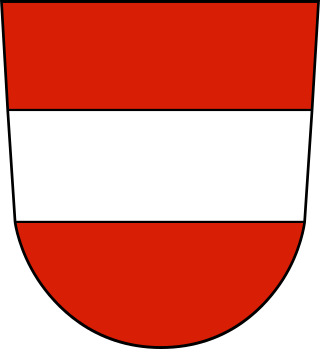
The House of Babenberg was a noble dynasty of Austrian Dukes and Margraves. Originally from Bamberg in the Duchy of Franconia, the Babenbergs ruled the imperial Margraviate of Austria from its creation in 976 AD until its elevation to a duchy in 1156, and from then until the extinction of the line in 1246, whereafter they were succeeded by the House of Habsburg, to which they were related.

Agnes of Poitou, was the queen of Germany from 1043 and empress of the Holy Roman Empire from 1046 until 1056 as the wife of Emperor Henry III. From 1056 to 1061, she ruled the Holy Roman Empire as regent during the minority of their son Henry IV.

The House of Lorraine originated as a cadet branch of the House of Metz. It inherited the Duchy of Lorraine in 1473 after the death without a male heir of Nicholas I, Duke of Lorraine. By the marriage of Francis of Lorraine to Maria Theresa of Austria in 1736, and with the success in the ensuing War of the Austrian Succession (1740–1748), the House of Lorraine was joined to the House of Habsburg and became known as the House of Habsburg‑Lorraine. Francis, his sons Joseph II and Leopold II, and his grandson Francis II were the last four Holy Roman emperors from 1745 until the dissolution of the empire in 1806. The House of Habsburg-Lorraine inherited the Habsburg Empire, ruling the Austrian Empire and then Austria-Hungary until the dissolution of the monarchy in 1918.

Leopold I, known as the Illustrious, a member of the House of Babenberg, was Margrave of Austria from 976 until his death. He was the first margrave of the Babenberg dynasty which ruled the March and Duchy of Austria until its extinction in 1246.

Leopold III, known as Leopold the Good, was the Margrave of Austria from 1095 to his death in 1136. He was a member of the House of Babenberg. He was canonized on 6 January 1485 and became the patron saint of Austria, Lower Austria, Upper Austria and Vienna. His feast day is 15 November.

Adalbert, known as Adalbert the Victorious, was the Margrave of Austria from 1018 until his death in 1055. He was a member of the House of Babenberg.

Leopold, known as Leopold the Generous, was margrave of Austria from 1136, and duke of Bavaria from 1139 until his death in 1141.
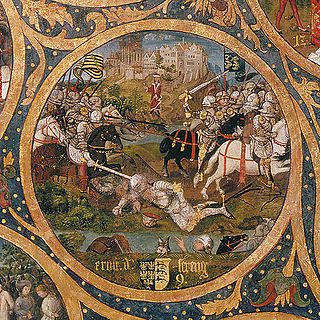
Ernest, known as Ernest the Brave, was the Margrave of Austria from 1055 to his death in 1075. He was a member of the House of Babenberg.
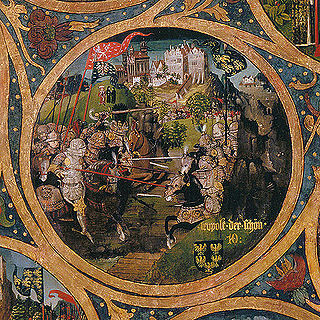
Leopold II, known as Leopold the Fair, a member of the House of Babenberg, was Margrave of Austria from 1075 until his death. A supporter of the Gregorian Reforms, he was one of the main opponents of the German king Henry IV during the Investiture Controversy.
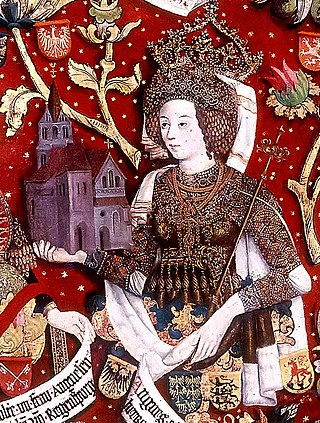
Agnes of Waiblingen, also known as Agnes of Germany, Agnes of Poitou and Agnes of Saarbrücken, was a member of the Salian imperial family. Through her first marriage, she was Duchess of Swabia; through her second marriage, she was Margravine of Austria.
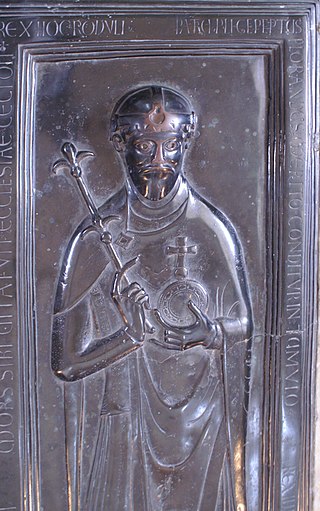
Rudolf of Rheinfelden was Duke of Swabia from 1057 to 1079. Initially a follower of his brother-in-law, the Salian emperor Henry IV, his election as German anti-king in 1077 marked the outbreak of the Great Saxon Revolt and the first phase of open conflict in the Investiture Controversy between Emperor and Papacy. After a series of armed conflicts, Rudolf succumbed to his injuries after his forces defeated Henry's in the Battle on the Elster.
Godfrey III, called the Bearded, was the eldest son of Gothelo I, Duke of Upper and Lower Lorraine.
The House of Sponheim or Spanheim was a medieval German noble family, which originated in Rhenish Franconia. They were immediate Counts of Sponheim until 1437 and Dukes of Carinthia from 1122 until 1269. Its cadet branches ruled in the Imperial County of Ortenburg-Neuortenburg and various Sayn-Wittgenstein states until 1806.
Lothair Udo II was Margrave of the Nordmark from 1057 until his death and also Count of Stade. He was the only son of Lothair Udo I of the Udonids and Adelaide of Rheinfelden.
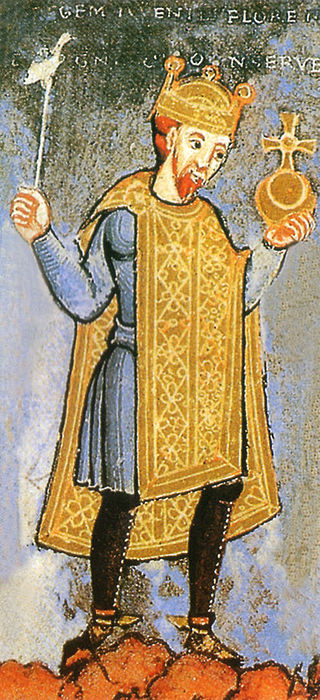
Henry III, called the Black or the Pious, was Holy Roman Emperor from 1046 until his death in 1056. A member of the Salian dynasty, he was the eldest son of Conrad II and Gisela of Swabia.
Esico of Ballenstedt is the progenitor of the House of Ascania,. Esico was the count of Ballenstedt, and his possessions became the nucleus of the later Principality of Anhalt.
Siegfried I is considered the progenitor of the Carinthian ducal House of Sponheim (Spanheimer) and all of its lateral branches, including the Counts of Lebenau and the Counts of Ortenburg. He is documented as Count of Sponheim from 1044 and served as margrave of the Hungarian March in 1045/46 and as count in the Puster Valley and the Lavant Valley from 1048 until his death.
Lothair Udo I, Margrave of Nordmark and Count of Stade, son of Siegfried II, Count of Stade, and Adela of Rhienfelden, daughter of Gero, Count of Alsleben. Lothair was the first of the House of Udonids to serve as margrave.